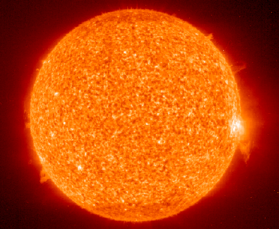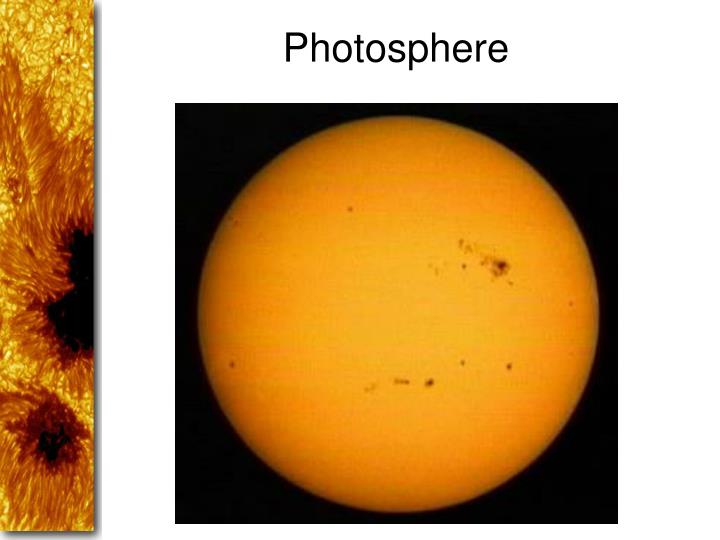
Doing so will destroy the retinas of your eyes. From that they've discovered that it consists of more that 60 elements, but 98 % of it is hydrogen and helium. Since the Sun is very hot we can't take a sample of it's "surface" and see what's in it, so instead scientists use spectroscopy, which means that they study the light that comes from the Sun. It reaches from the surface visible at the center of the solar disk to about 250 miles (400 km) above that. This problem still waits for an answer, but it seems to be magnetic energy that turns into heat energy. You might think it seems weird that the outer layers are hotter than the surface of the Sun (which is "only" 6000 degrees). Because of its high temperature, the solar corona is a source of x rays and a photo of it shows that the corona has loops and both dark and bright regions. It was first observed during solar eclipses (like the chromosphere) and it's been known for many centuries. Even if the temperature in the core of the Sun does reach 15 million degrees, it drops to a mere 5000 degrees at the surface. The chromosphere reaches into the outermost part of the atmosphere the corona. The problem is, no one can really explain how this corona exists. The region in the solar atmosphere where the temperature changes from 10,000 degrees (typical of the chromosphere) to nearly a million degrees (characteristic of the corona) is called the transition region. The Chromosphere is 2-3000 km thick and studies show that the temperature increases through the chromosphere, from 4200 degrees at the photosphere to 100,000 degrees at the upper levels of the Chromosphere. It is visible only when the photosphere is blocked (for example during a solar eclipse). The Chromosphere lies immediately above the photosphere and consists of a less dense gas. Granules form and disappear within a couple of minutes. Each granule is almost 1000 km across and has a dark boundary. Under good observing conditions with a telescope (with special dark filters for protection) it's possible to see a pattern called granulation. The temperature here varies from 4000 degrees to almost 8000 degrees and the density also depends on how deep we dive into the Sun. It's not a sharp surface but consists of gas spanning a distance of almost 400 kilometers. This is what we see when we look at the Sun, and it's the lowest part of the atmosphere. There are three main regions the photosphere, the chromosphere and the corona. Https://wiki/File:Solarcorona.The Sun's outer layers are known as it's atmosphere and they are the only layers we can observe directly. The corona can only be seen during a total solar eclipse that covers both the photosphere and the chromosphere. The corona appears bright in X-ray photos in places where magnetic fields trap hot gas. The spectrum of sunlight has approximately the spectrum of a black-body radiating at 5,777 K (5,504 ☌ 9,939 ☏), interspersed with atomic absorption lines from the tenuous layers above the photosphere. The temperature of the photosphere is 5,780 degrees as compared to the temperature of. Like the chromosphere, the corona is not visible from Earth except during a total solar eclipse where the Moon covers both the photosphere and the chromosphere. Features of the Photosphere It is the most visible surface of the sun. The Sun's rotation axis is tilted by about 7.15 degrees from the axis of the Earth's orbit so we see more of the Sun's north pole in September of each year and more of its south pole in March. This rotation was first detected by observing the motion of sunspots in the photosphere. This heat source is probably from electromagnetic interactions of its atoms. The Sun rotates on its axis once in about 27 days. With a temperature of about 1 million K, the corona is significantly hotter than the chromosphere, indicating that it must have a source of heat other than energy released from the lower regions.

The outermost layer of the solar atmosphere is the corona. The chromosphere can only be seen from Earth during a total solar eclipse. Because the radiation from the solar interior is absorbed and then re-emitted by the photosphere, we cannot use spectral analysis to analyze the Sun’s interior. Spectral analysis can tell us what elements are present in the chromosphere and photosphere. Slightly cooler than the photosphere, the chromosphere is only visible during a total solar eclipse when the Moon blocks all the light from the photosphere. The various layers of the Sunįrom the top of the photosphere, at about 1500 km thick and a temperature of about 5000 K in temperature is the chromosphere. It is the light from the photosphere that we detect on Earth as visible light.

The photosphere is about 500 km thick and has a temperature about 6000 K. The Sun lacks a solid surface, but if it can be said to have a surface of any kind, it would be the photosphere, the visible, granulated region that sits on top of the convection zone.


No headers The surface of the Sun exhibits constant activity.


 0 kommentar(er)
0 kommentar(er)
